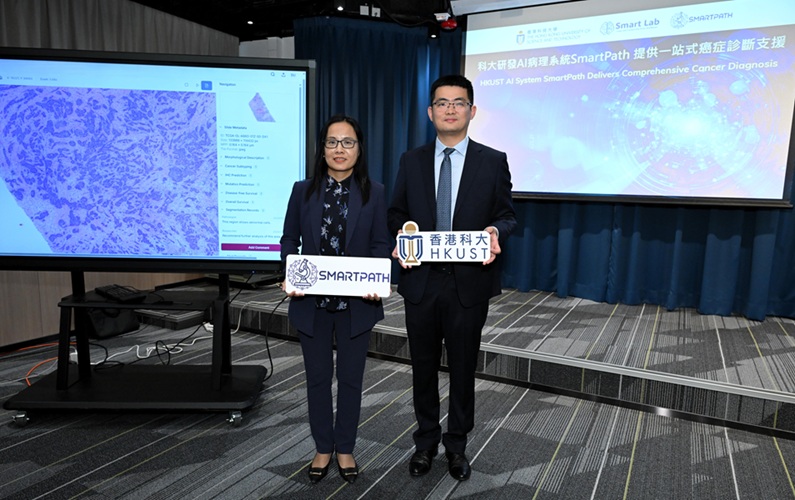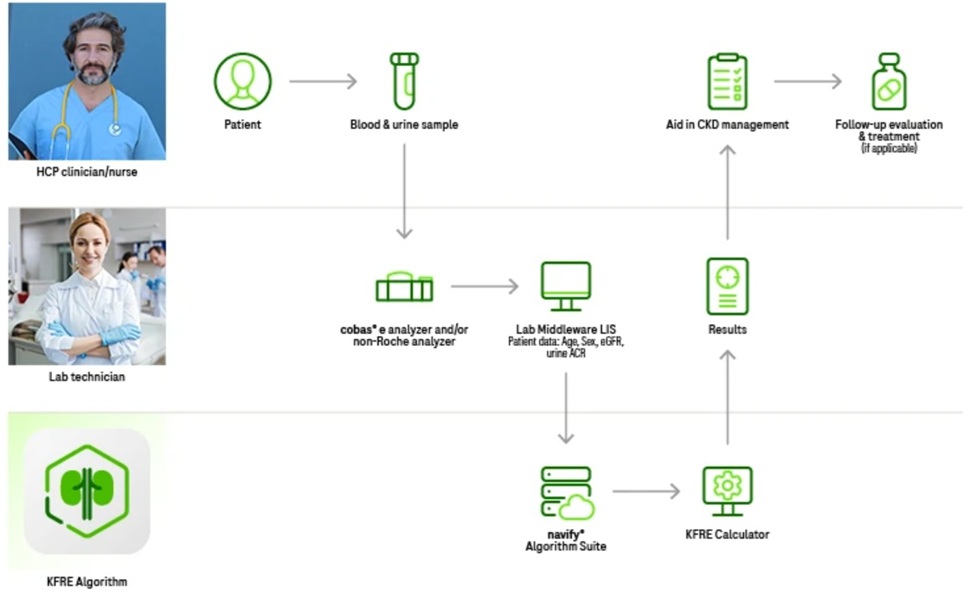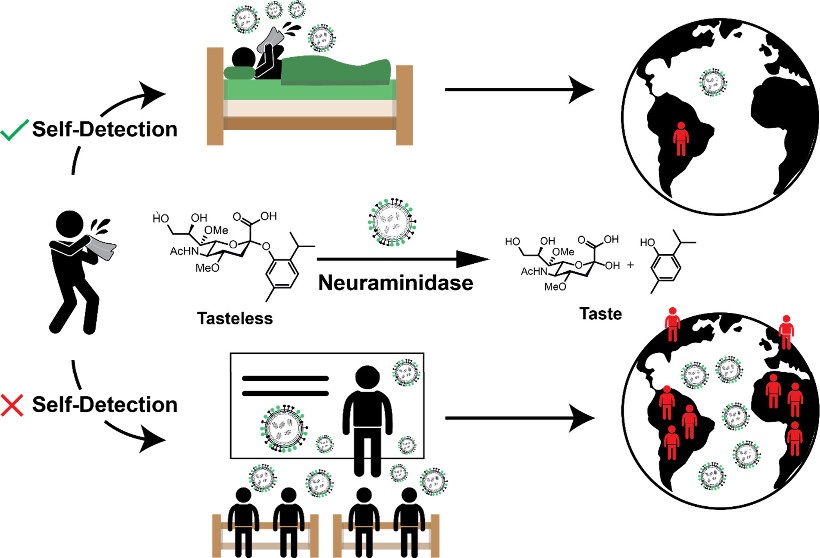Influenza Array to Study Genetic Drift of H1N1 Swine Flu
|
By LabMedica International staff writers Posted on 12 Nov 2009 |
A U.S. Army medical center is using a new influenza detection system to analyze influenza cases, including those involving H1N1 swine flu.
CombiMatrix Corp. (Mukilteo, WA, USA) announced that Brooke Army Medical Center (BAMC; San Antonio, CA, USA) is using the CombiMatrix influenza detection array. Brooke Army Medical Center (BAMC; San Antonio, TX, USA) is a military hospital that is investigating the feasibility of screening all patients presenting in its emergency room with symptoms of respiratory distress and consenting to nasal swabs, by both electrochemical array-based diagnostics and bead-based multiplex fluorescent methods.
While there are other flu tests including the fluorescent test used at BAMC that can identify the presence or absence of H1N1 swine flu, they do not provide information on genetic drift of the virus. It is important to understand the genetic drift of rapidly mutating pathogens in general and of swine flu in particular because of the potential for increased pathogenicity of a mutated virus.
Worldwide, there are already several hundred thousand confirmed cases, and the World Health Organization (Geneva, Switzerland) has declared a pandemic. Although some of these estimates might be high, the numbers distinctly indicate that this viral disease is a major public health concern. Because swine flu can be a rapidly mutating virus, concerns exist about mutations that might make it more pathogenic while maintaining its highly infectious nature.
"We are pleased to be working with BAMC to evaluate the genetic drift of the swine flu virus,” stated Dr. Amit Kumar, president and CEO of CombiMatrix. "Our influenza array has demonstrated its ability to provide tremendous genetic information regarding numerous infectious agents including bird flu, swine flu, and other infectious agents. It is especially significant to note that our influenza detection system was developed with funding from the U.S. Department of Defense, and it is now being used to evaluate infections in military, former-military, and government personnel. Also, we encourage interested parties to review information on the website of the U.S. Centers for Disease
Control and Prevention [CDC; Atlanta, GA, USA] to get an understanding of the limitations of currently available flu tests, especially what we feel is poor performance of many rapid flu tests,” concluded Dr Kumar. The link for this information is as follows given below.
According to Dr. Gerald Merrill, laboratory director for the department of clinical investigation at BAMC, "We are already seeing a high percentage of novel H1N1 flu cases in the San Antonio military community this season. The CombiMatrix system allows us to screen for Swine flu versus seasonal influenza A and influenza B. Samples analyzed using the CombiMatrix system from last season allowed us to look at clustering of genotypes and to see patterns suggesting genetic drift in both the novel H1N1 swine flu virus and the seasonal influenza A virus in San Antonio. This can be useful in spotting divergence of strains and possibly, in identifying problems earlier than if we did not screen for such divergence,” concluded Dr. Merrill.
CombiMatrix is a biotechnology business that develops proprietary technologies, including products and services in the areas of drug development, genetic analysis, molecular diagnostics, nanotechnology, and defense and homeland security markets, as well as in other potential markets where our products and services could be utilized. The technologies the company has developed include a platform technology to rapidly produce user-defined, in situ synthesized, oligonucleotide arrays for use in identifying and determining the roles of genes, gene mutations, and proteins. This technology has a wide range of potential applications in the areas of genomics, proteomics, biosensors, drug discovery, drug development, diagnostics, combinatorial chemistry, material sciences, and nanotechnology. Other technologies include proprietary molecular synthesis and screening methods for the discovery of potential new drugs.
Related Links:
CombiMatrix
CDC Guidance for Diagnostic tests
CombiMatrix Corp. (Mukilteo, WA, USA) announced that Brooke Army Medical Center (BAMC; San Antonio, CA, USA) is using the CombiMatrix influenza detection array. Brooke Army Medical Center (BAMC; San Antonio, TX, USA) is a military hospital that is investigating the feasibility of screening all patients presenting in its emergency room with symptoms of respiratory distress and consenting to nasal swabs, by both electrochemical array-based diagnostics and bead-based multiplex fluorescent methods.
While there are other flu tests including the fluorescent test used at BAMC that can identify the presence or absence of H1N1 swine flu, they do not provide information on genetic drift of the virus. It is important to understand the genetic drift of rapidly mutating pathogens in general and of swine flu in particular because of the potential for increased pathogenicity of a mutated virus.
Worldwide, there are already several hundred thousand confirmed cases, and the World Health Organization (Geneva, Switzerland) has declared a pandemic. Although some of these estimates might be high, the numbers distinctly indicate that this viral disease is a major public health concern. Because swine flu can be a rapidly mutating virus, concerns exist about mutations that might make it more pathogenic while maintaining its highly infectious nature.
"We are pleased to be working with BAMC to evaluate the genetic drift of the swine flu virus,” stated Dr. Amit Kumar, president and CEO of CombiMatrix. "Our influenza array has demonstrated its ability to provide tremendous genetic information regarding numerous infectious agents including bird flu, swine flu, and other infectious agents. It is especially significant to note that our influenza detection system was developed with funding from the U.S. Department of Defense, and it is now being used to evaluate infections in military, former-military, and government personnel. Also, we encourage interested parties to review information on the website of the U.S. Centers for Disease
Control and Prevention [CDC; Atlanta, GA, USA] to get an understanding of the limitations of currently available flu tests, especially what we feel is poor performance of many rapid flu tests,” concluded Dr Kumar. The link for this information is as follows given below.
According to Dr. Gerald Merrill, laboratory director for the department of clinical investigation at BAMC, "We are already seeing a high percentage of novel H1N1 flu cases in the San Antonio military community this season. The CombiMatrix system allows us to screen for Swine flu versus seasonal influenza A and influenza B. Samples analyzed using the CombiMatrix system from last season allowed us to look at clustering of genotypes and to see patterns suggesting genetic drift in both the novel H1N1 swine flu virus and the seasonal influenza A virus in San Antonio. This can be useful in spotting divergence of strains and possibly, in identifying problems earlier than if we did not screen for such divergence,” concluded Dr. Merrill.
CombiMatrix is a biotechnology business that develops proprietary technologies, including products and services in the areas of drug development, genetic analysis, molecular diagnostics, nanotechnology, and defense and homeland security markets, as well as in other potential markets where our products and services could be utilized. The technologies the company has developed include a platform technology to rapidly produce user-defined, in situ synthesized, oligonucleotide arrays for use in identifying and determining the roles of genes, gene mutations, and proteins. This technology has a wide range of potential applications in the areas of genomics, proteomics, biosensors, drug discovery, drug development, diagnostics, combinatorial chemistry, material sciences, and nanotechnology. Other technologies include proprietary molecular synthesis and screening methods for the discovery of potential new drugs.
Related Links:
CombiMatrix
CDC Guidance for Diagnostic tests
Latest Molecular Diagnostics News
- Urine Test Could Replace Painful Kidney Biopsies for Lupus Patients
- Blood Test Guides Post-Surgical Immunotherapy for Muscle-Invasive Bladder Cancer
- Mitochondrial DNA Mutations from Kidney Stressors Could Predict Future Organ Decline
- Blood Test Could Predict Bariatric Surgery Outcomes in Teenagers
- ctDNA Blood Test to Help Personalize Postsurgical Colon Cancer Treatment
- AI Powered Blood Test Predicts Suicide Risk in Bipolar Patients
- DNA Sensor Enables Molecular Detection from Single Blood Drop
- DNA-Powered Test Accurately Detects E. Coli Lookalike Bacteria
- World’s Fastest DNA Sequencing Technique to Revolutionize NICU Genomic Care
- Blood Test Uses Cell-Free DNA to Detect ALS Faster and More Accurately
- Multi-Cancer Early Detection Blood Test Increases Cancer Detection
- Portable Label-Free Device Tracks Alzheimer's Disease in Real Time
- Liquid Biopsy Test Enables Early Detection of ICI-Related Myocarditis
- Rapid POC Diagnostic Test Detects Asymptomatic Malaria Cases
- Improved DNA Sequencing Tool Uncovers Hidden Mutations Driving Cancer
- Newborn Genomic Screening Enables More Lifesaving Diagnoses
Channels
Clinical Chemistry
view channel
VOCs Show Promise for Early Multi-Cancer Detection
Early cancer detection is critical to improving survival rates, but most current screening methods focus on individual cancer types and often involve invasive procedures. This makes it difficult to identify... Read more
Portable Raman Spectroscopy Offers Cost-Effective Kidney Disease Diagnosis at POC
Kidney disease is typically diagnosed through blood or urine tests, often when patients present with symptoms such as blood in urine, shortness of breath, or weight loss. While these tests are common,... Read moreHematology
view channel
Viscoelastic Testing Could Improve Treatment of Maternal Hemorrhage
Postpartum hemorrhage, severe bleeding after childbirth, remains one of the leading causes of maternal mortality worldwide, yet many of these deaths are preventable. Standard care can be hindered by delays... Read more
Pioneering Model Measures Radiation Exposure in Blood for Precise Cancer Treatments
Scientists have long focused on protecting organs near tumors during radiotherapy, but blood — a vital, circulating tissue — has largely been excluded from dose calculations. Each blood cell passing through... Read more
Platelets Could Improve Early and Minimally Invasive Detection of Cancer
Platelets are widely recognized for their role in blood clotting and scab formation, but they also play a crucial role in immune defense by detecting pathogens and recruiting immune cells.... Read more
Portable and Disposable Device Obtains Platelet-Rich Plasma Without Complex Equipment
Platelet-rich plasma (PRP) plays a crucial role in regenerative medicine due to its ability to accelerate healing and repair tissue. However, obtaining PRP traditionally requires expensive centrifugation... Read moreImmunology
view channel
Signature Genes Predict T-Cell Expansion in Cancer Immunotherapy
Modern cancer immunotherapies rely on the ability of CD8⁺ T cells to rapidly multiply within tumors, generating the immune force needed to eliminate cancer cells. However, the biological triggers behind... Read more
Molecular Microscope Diagnostic System Assesses Lung Transplant Rejection
Lung transplant recipients face a significant risk of rejection and often require routine biopsies to monitor graft health, yet assessing the same biopsy sample can be highly inconsistent among pathologists.... Read moreMicrobiology
view channel
Fast Noninvasive Bedside Test Uses Sugar Fingerprint to Detect Fungal Infections
Candida bloodstream infections are a growing global health threat, causing an estimated 6 million cases and 3.8 million deaths annually. Hospitals are particularly vulnerable, as weakened patients after... Read more
Rapid Sepsis Diagnostic Device to Enable Personalized Critical Care for ICU Patients
Sepsis is a life-threatening condition that occurs when the body’s response to infection spirals out of control, damaging organs and leading to critical illness. Patients often arrive at intensive care... Read morePathology
view channel
Tears Offer Noninvasive Alternative for Diagnosing Neurodegenerative Diseases
Diagnosing and monitoring eye and neurodegenerative diseases often requires invasive procedures to access ocular fluids. Ocular fluids like aqueous humor and vitreous humor contain valuable molecular information... Read more
AI-Powered Method Combines Blood Data to Accurately Measure Biological Age
Chronological age tells us how many years we’ve lived, but not how quickly our bodies are ageing. Some people stay healthy well into their 80s or 90s, while others experience decline much earlier.... Read moreTechnology
view channel
Viral Biosensor Test Simultaneously Detects Hepatitis and HIV
Globally, over 300 million people live with Hepatitis B and C, and 40 million with HIV, according to WHO estimates. Diagnosing bloodborne viruses such as HIV and Hepatitis B and C remains challenging in... Read more
Acoustofluidic Device to Transform Point-Of-Care sEV-Based Diagnostics
Rapid and sensitive detection of small extracellular vesicles (sEVs)—key biomarkers in cancer and organ health monitoring—remains challenging due to the need for multiple preprocessing steps and bulky... Read moreIndustry
view channel
Advanced Instruments Merged Under Nova Biomedical Name
Advanced Instruments (Norwood, MA, USA) and Nova Biomedical (Waltham, MA, USA) are now officially doing business under a single, unified brand. This transformation is expected to deliver greater value... Read more





















